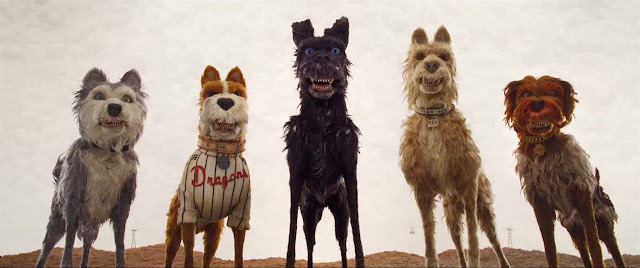Isle of Dogs (2018)
Whether he knows it or not, Wes Anderson is an animator trapped in a filmmaker's body. Like Tim Burton, he's a visionary director with a peculiar, oddball style of telling stories. But when he gets into the realm of stop-motion animation, there is no limit to where his imagination takes him. Isle of Dogs is one of the most spectacularly beautiful pieces of animation in a very long time. As to where this falls in Anderson's filmography, I'd put it near the top and quite a few spots above The Grand Budapest Hotel, a film that's perceived to be his masterpiece. It wasn't, but this one just might be it.
From the opening shot, I couldn't take my eyes off of the screen. I let go of every perceivable reservation and let Anderson's entire universe overtake me. What a universe it is.
Somewhere in the not so distant future, a Japanese city called Megasaki is run by cynophobic, cat supremacist, fascist, Mayor Kobayashi. He institutes extreme measures of quarantine and expulsion of dogs from his city after a curious case of dog flu threatens his citizens. The dogs, now stranded on Trash Island, forage and try to stay alive yet seem to communicate like self-aware entities in an old Woody Allen comedy. The five dogs we meet are voiced by Anderson favorites (Norton, Murray, Goldblum, Balaban) with the exception of Bryan Cranston, who plays the feral stray dog leader, Chief. The designs of these dogs all have something to gaze in wonder at. For example Boss (Murray) has dark button eyes and wears an adorable sweater as the former mascot of a local junior baseball team. Another dog we see later in the film named Jupiter, played by F. Murray Abraham, sports a canteen of "turpentine brandy" around his neck. All are furry and all are downright cuddly. Torpedoing from Megasaki is a stowaway child pilot named Atari Kobayashi, on a mission to rescue his beloved dog Spots (Liev Schrieber) from Trash Island. Meanwhile, an underground resistance of the Mayor and his iron fisted rule is growing in Megasaki. Leading it is an American foreign exchange student, Tracy, played by Greta Gerwig. I could only describe her as a cross between Norma Rae and Little Orphan Annie. She uncovers a conspiracy which proves indefinitely that the epidemic of dog flu was invented by the government in order to eradicate Dogs as a species, Nazi style.
With an engaging plot like that and such richly constructed environments and characters such as these, nearly everything should go right and it does. It's 100 minutes of bliss. It never deviates from Wes Anderson's signature narrative style which at times has proven to be grating in live-acting. But in the world of stop-motion animation, it's enchanting and it fits him like a glove. I found myself to be the only person laughing out-loud in the theater, not because the movie is deliberately trying to make me laugh, but out of sheer joy at the amount of fun Anderson had in making this. But we had to wait 10 years to see him dare to venture into this world again. Here is a word of advice. Wes, animation is your greatest strength. Keep doing it.






Comments
Post a Comment